Architecture Home Styles
Which Is Better: Bungalow or 2 Storey? Pros and Cons
Baffled between a bungalow and a two-storey? Uncover the essential pros and cons to help you make the right choice for your next home.
When pondering the choice between a bungalow and a two-storey dwelling, one must consider various aspects to make an informed decision. Each option presents its own set of advantages and drawbacks that can significantly impact daily living.
The layout, maintenance, resale value, and even future accessibility are all crucial factors to contemplate.
By carefully examining the pros and cons of each type of home, one can better determine which suits their needs and preferences.
Key Takeaways
- Bungalows offer single-level living for accessibility and ease of maintenance.
- Two-storey homes provide more space and privacy with separate living areas.
- Renovations enhance the resale value of both bungalows and two-storey houses.
- Both types offer customization options, allowing homeowners to personalize their living spaces.
Space Considerations
When considering space in your home, bungalows and two-storey homes offer distinct advantages that cater to different lifestyle needs. Bungalows, with their single-level layout, provide easy accessibility for all family members and are ideal for those seeking convenient, all-on-one-floor living options. Despite potentially having a smaller footprint, bungalows can be easily expanded with additions to increase the square footage as needed. This flexibility allows homeowners to customize their living space to suit their preferences without the constraint of multiple levels.
On the other hand, two-storey homes maximize space by building upwards on small blocks of land, providing more square footage on the same land area. This design is perfect for individuals or families looking for more privacy, as bedrooms and living areas can be separated between the floors. The vertical layout also offers distinct spaces for various activities, allowing for better organization and segregation of living areas.
Maintenance Requirements

Considering the distinct advantages in space between bungalows and two-storey homes, it's essential to recognize the varying maintenance requirements associated with each type of dwelling.
When it comes to maintenance, here are some key points to consider:
- Accessibility and Complexity: One-story houses are generally easier to maintain and repair due to their simple structure and easy accessibility. In contrast, two-story homes often have more complex systems, such as dual HVAC setups, which can increase maintenance complexity.
- Gutter Cleaning: Cleaning gutters in two-story houses can pose a more significant challenge compared to single-story homes. The height and accessibility factor into the difficulty of this task, making it more time-consuming and potentially requiring professional assistance.
- Roof Repairs: Repairing roof issues is typically simpler and more accessible in bungalows due to the lower height. In contrast, two-story homes may require specialized equipment and professionals for roof maintenance, potentially increasing maintenance costs.
Understanding these maintenance differences can help homeowners make informed decisions when choosing between bungalows and two-storey homes.
Property Value and Resale Potential
Exploring the impact of property value and resale potential, both bungalows and two-storey homes offer distinct advantages that can influence buyers' decisions. One key factor affecting property value is the size of the home. Two-storey houses typically provide more square footage, which can attract buyers looking for a larger home.
On the other hand, bungalows offer a single-level living space that may appeal more to older buyers seeking convenience and ease of access. Additionally, the layout of two-storey homes can provide increased privacy, with bedrooms often located on the second floor, making them desirable for families.
Renovations and upgrades play a crucial role in enhancing the resale value of both property types. Historical trends in appreciation rates and the location of the property are also significant contributors to determining the property value and resale potential of bungalows and two-storey homes. Buyers should carefully consider these factors when making their real estate investment decisions.
Customization and Design Options
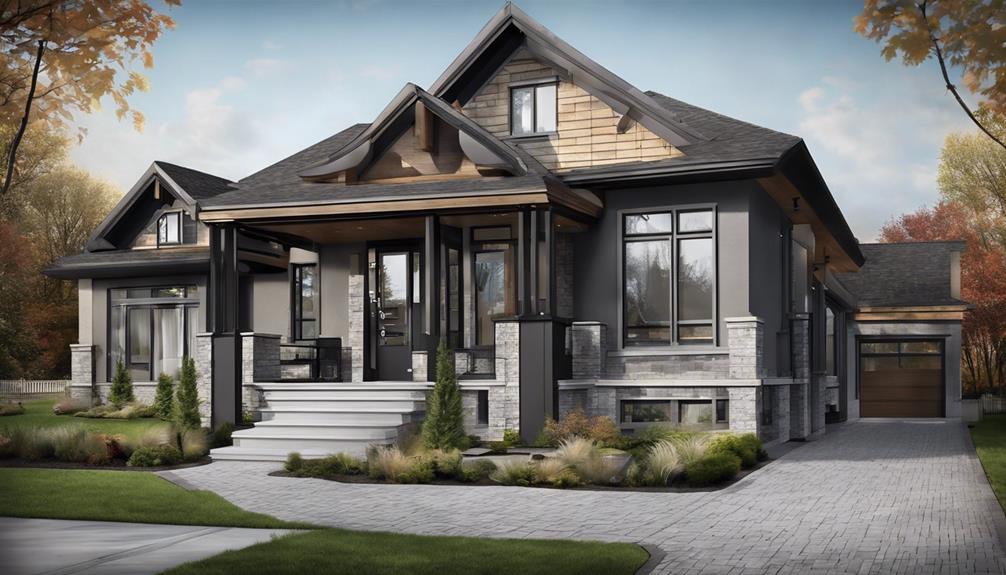
In customizing your home's design, two-story houses offer a plethora of exterior options, while bungalows provide ample interior layout flexibility. When considering the customization and design options of each type of home, there are key factors to keep in mind:
- Exterior Versatility: Two-story homes allow for a diverse range of exterior designs, including varied roof styles and facades, offering homeowners the opportunity to create a visually striking curb appeal.
- Interior Flexibility: Bungalows, with their open floor plan design, provide homeowners with the freedom to customize interior layouts to suit their preferences, such as creating spacious living areas or cozy nooks for relaxation.
- Architectural Features: Two-story houses present opportunities for creative stair designs and landing areas that not only add functionality but also enhance the overall aesthetic appeal of the home.
Both bungalows and two-story homes offer unique avenues for customization through material choices, color schemes, and architectural details, allowing homeowners to tailor their living space to reflect their personal style and preferences.
Energy Efficiency and Utility Costs
Moving from the discussion of customization and design options, the impact of energy efficiency and utility costs in both bungalow and two-story homes becomes a crucial factor to consider when evaluating the practical aspects of each housing type.
When it comes to heating and cooling expenses, two-story houses may have a slight advantage due to their smaller roof area, which can reduce overall costs. However, one-story houses often benefit from better natural lighting, potentially decreasing energy usage during daylight hours. Proper insulation is key in both housing types to ensure energy efficiency.
Additionally, investing in energy-efficient appliances can lead to significant savings on utility bills for both one and two-story homes. Despite the advantages of two-story houses in terms of heating and cooling efficiency, the overall energy efficiency of a home ultimately depends on various factors, including insulation quality and appliance efficiency, rather than solely on the house's height.
Accessibility and Aging in Place
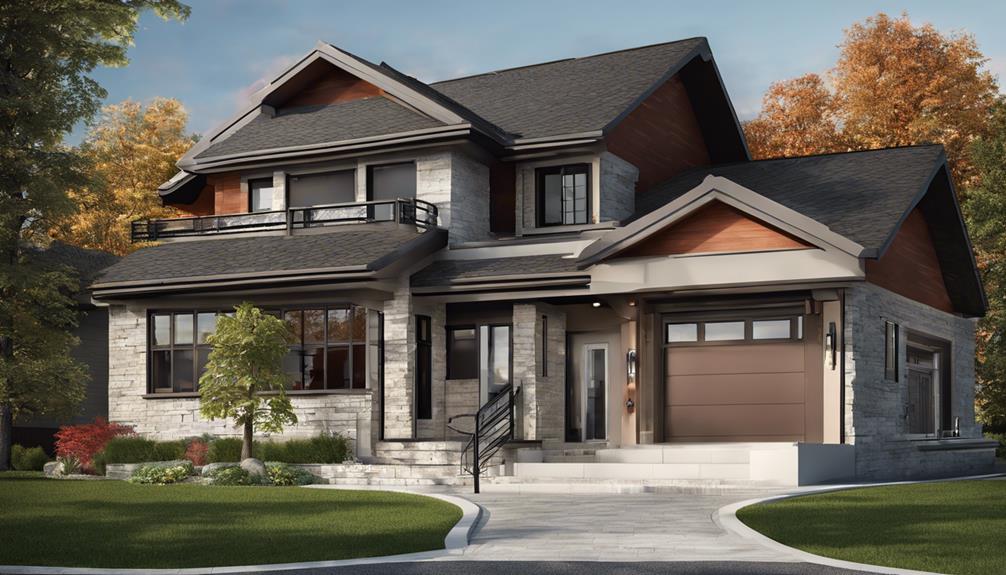
Considering the practicality of housing options for individuals with mobility challenges, bungalows stand out as an ideal choice due to their single-level layouts providing easy accessibility. Bungalows offer a range of benefits for aging in place and accessibility:
- Seamless Mobility: Bungalows eliminate the need to navigate stairs, offering a seamless transition for individuals with limited mobility to move around independently.
- Safety and Independence: The single-level design of bungalows promotes safety and independence, allowing residents to perform daily activities without obstacles commonly found in two-storey homes.
- Future-Proof Living: Bungalows cater to changing mobility needs over time, providing a living space that can easily accommodate mobility aids and adjustments as residents age in place.
Construction and Building Costs
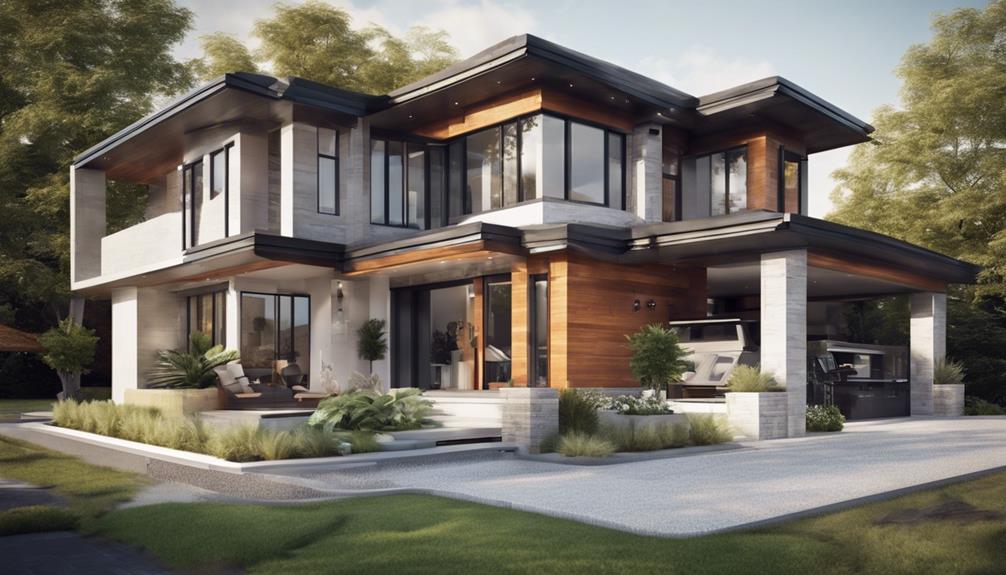
When considering construction and building costs between bungalows and two-storey homes, it's essential to weigh the differences in cost variations between styles.
The materials used in construction can significantly impact the overall budget of the project.
Comparing labor expenses between the two styles is crucial in determining the most cost-effective option for your needs.
Cost Variations Between Styles
In comparing the construction and building costs between bungalow and two-storey homes, it's evident that two-storey homes generally have a lower cost per square foot to build. This is due to their ability to maximize space efficiency by stacking levels. However, there are additional cost considerations that impact the overall budget:
- Land Costs: Bungalows often require a larger land footprint, potentially increasing land costs.
- Foundation Complexity: Construction costs for two-storey homes may be higher due to the need for a more complex foundation.
- Design Influence: The overall cost difference between bungalows and two-storey homes may vary based on location and specific design features.
These factors highlight the importance of assessing various cost elements when deciding between these housing styles.
Materials Impact on Budget
The selection of materials plays a pivotal role in shaping the budget for both bungalow and two-storey construction projects. When considering the floor plan and material costs, it's essential to weigh the impact of high-quality materials like hardwood flooring or granite countertops, which can escalate overall expenses.
Conversely, opting for cost-effective alternatives such as laminate flooring or quartz countertops can help in cost reduction. Additionally, the choice of roofing material, whether asphalt shingles or metal roofing, can significantly influence the budget for both types of homes.
Labor Expenses Comparison
Considering the complexity of construction techniques and structural requirements, labor expenses differ significantly between bungalow and two-storey homes. When it comes to labor expenses, two-storey homes generally involve higher costs due to the intricacies of building vertically and the additional structural considerations. On the other hand, bungalows often require less skilled labor and time, leading to lower overall labor expenses.
Here are three key points to consider when comparing labor expenses between the two options:
- Bungalow construction usually involves simpler building processes, resulting in lower labor costs.
- Two-storey homes may require specialized expertise for multi-level construction, potentially increasing skilled labor expenses.
- The time and labor required for a bungalow are typically less than for a two-storey home, impacting overall building expenses.
Privacy and Noise Concerns

When evaluating bungalow and two-storey homes, privacy and noise concerns play a significant role in determining the ideal living environment.
Two-storey homes offer increased privacy for upper-floor bedrooms, shielding them from ground-level views and potential intrusions. This privacy advantage can be especially appealing for those seeking a more secluded living space.
On the other hand, bungalows excel in reducing noise transmission between rooms due to their single-level construction. This can create a quieter and more peaceful indoor environment, ideal for individuals sensitive to noise disturbances.
Additionally, bungalows often provide more distance from neighbors, further enhancing privacy compared to the closer proximity typically found in two-storey homes.
However, two-storey houses can help minimize noise disturbances between floors, enhancing overall comfort. Ultimately, the choice between a bungalow and a two-storey home will depend on individual preferences regarding privacy and noise levels within the living space.
Lifestyle and Family Dynamics
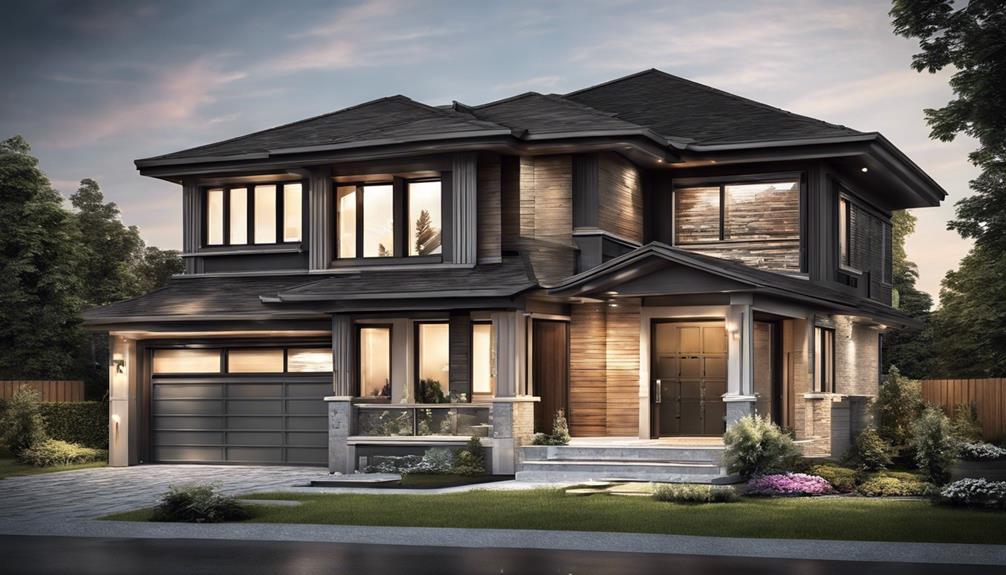
When considering lifestyle and family dynamics, the layout of a home can significantly impact our daily routines and interactions.
The choice between a bungalow or a two-storey home influences how we utilize space for activities, prioritize privacy, and manage noise levels within our living environment.
Understanding these factors can help us make informed decisions that align with the needs and dynamics of our family unit.
Space for Activities
For families seeking distinct spaces tailored to various activities, two-storey homes provide enhanced privacy and noise isolation compared to bungalows. When considering the space for activities in your home, here are some key points to keep in mind:
- Separation of Spaces: Two-storey homes offer the advantage of separating living areas from sleeping quarters, allowing for uninterrupted activities even when others are resting.
- Individual Needs: Larger families may benefit from the multiple rooms and levels in a two-storey home, accommodating diverse activities and individual preferences simultaneously.
- Supervision Ease: Bungalows, on the other hand, are ideal for families with young children where supervision during activities is crucial due to the interconnected layout.
Carefully evaluating your family's lifestyle dynamics will help determine whether a bungalow or two-storey home aligns better with your activity needs.
Privacy and Noise
Privacy and noise considerations play a significant role in shaping the lifestyle and family dynamics of homeowners choosing between bungalows and two-storey homes.
Two-storey homes offer enhanced privacy for upper-floor bedrooms, while bungalows can achieve increased privacy through landscaping and distance from the street.
The separation of living spaces in two-storey homes helps minimize noise transmission between floors, making them suitable for households seeking quieter environments. On the other hand, bungalows are preferred by those looking to reduce potential noise disruptions and maintain a peaceful living atmosphere.
Both housing options offer distinct advantages concerning privacy and noise management, allowing homeowners to select based on their specific preferences and lifestyle needs.
Frequently Asked Questions
Is Bungalow Better Than 2 Story House?
When considering if a bungalow is better than a two-story house, factors like accessibility, privacy, and maintenance costs come into play.
Bungalows offer single-level living ideal for aging in place and can be more cost-effective in terms of cooling. However, two-story homes may provide more privacy for upper-floor bedrooms.
It ultimately depends on individual preferences and priorities when choosing between a bungalow or a two-story house.
What Are the Disadvantages of Bungalow?
Let's dive into the disadvantages of bungalows. They can have limited privacy with bedrooms near common areas, potentially being less energy-efficient than two-storey homes. In certain markets, bungalows might've a lower resale value.
Additionally, the single-storey design could lead to limited views and natural light. Living and sleeping areas may also lack separation in bungalows. These factors need consideration when deciding on a bungalow versus a two-storey home.
What Are the Disadvantages of a Two-Story House?
When considering two-story houses, it's important to note the challenges they pose. Accessibility issues, increased noise, and higher maintenance needs are common downsides.
Additionally, the need for two HVAC systems can lead to higher energy costs. Safety concerns during emergencies, especially evacuating upper floors, are also worth considering.
Assessing these factors can help make an informed decision about whether a two-story home is the right fit for you.
Why Are Two-Story Houses Better?
Two-story houses offer distinct advantages such as:
- Better separation of public and private areas
- Increased privacy for upper-floor bedrooms
- Potential cost savings on plumbing and electrical work
- Enhanced structural support for upper levels
- The possibility of a balcony for an improved view
These features make two-story homes a compelling choice for those seeking functional and aesthetically pleasing living spaces.
Conclusion
In the end, whether you choose a bungalow or a two-storey home, remember that your decision should reflect your unique lifestyle and needs.
Picture yourself in each space, enjoying the cozy charm of a bungalow or the expansive views from a two-storey home.
Consider the practical aspects, but also envision the memories you'll create in your new abode.
Choose the option that speaks to your heart and fits seamlessly into your dream life.
- About the Author
- Latest Posts
Introducing Ron, the home decor aficionado at ByRetreat, whose passion for creating beautiful and inviting spaces is at the heart of his work. With his deep knowledge of home decor and his innate sense of style, Ron brings a wealth of expertise and a keen eye for detail to the ByRetreat team.
Ron’s love for home decor goes beyond aesthetics; he understands that our surroundings play a significant role in our overall well-being and productivity. With this in mind, Ron is dedicated to transforming remote workspaces into havens of comfort, functionality, and beauty.
Architecture Home Styles
How to Have a Tiny Home in Arizona: Your Essential Guide
Fascinated by the idea of a tiny home in Arizona? Discover how tax considerations can impact your journey in this essential guide.
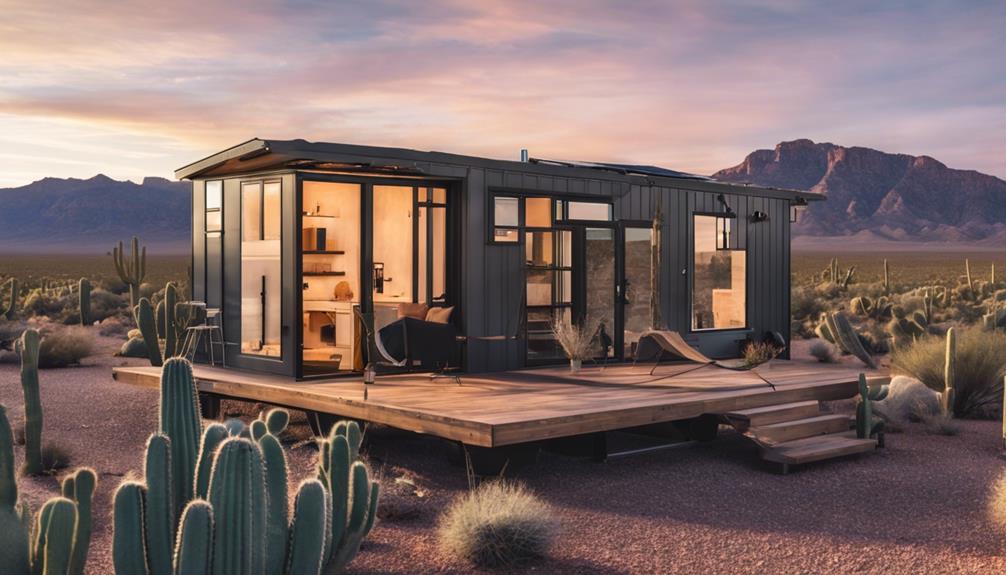
Embarking on the journey of having a tiny home in Arizona is like navigating through a desert oasis, each step revealing new insights and challenges. From understanding the intricate web of zoning laws to discovering the perfect location that aligns with your tiny living dreams, this essential guide equips you with the knowledge needed to turn your tiny home vision into reality.
But what about the unique tax considerations that come with owning a tiny home in Arizona? Stay tuned to uncover key insights that will make a difference in your tiny home journey.
Key Takeaways
- Understand Arizona zoning laws for placement in suitable zones.
- Seek permits for tiny homes based on location and structure type.
- Explore tax benefits for tiny homeowners through property tax exemptions.
- Build a supportive community through local groups and events for guidance.
Zoning Laws and Regulations in Arizona
When navigating the realm of tiny home living in Arizona, understanding the intricacies of zoning laws and regulations becomes paramount. In Arizona, zoning laws permit tiny houses on foundations in multifamily, detached single-family, and accessory dwelling unit zones.
However, for Tiny Homes on Wheels, they're typically classified as recreational vehicles and must adhere to specific parking regulations within designated zones. Maricopa County has established particular regulations for tiny houses, including constraints on the floor area allowed for permanent structures. On the other hand, Pima County imposes restrictions on Tiny Homes on Wheels through specific codes that govern their placement.
The zoning options for tiny houses in Arizona encompass various zones such as isolated single-family zones, accessory dwelling unit zones, and multifamily zones. Familiarizing oneself with these zoning laws and regulations is crucial for anyone considering embarking on the adventure of tiny home living in Arizona.
Ideal Locations for Tiny Homes
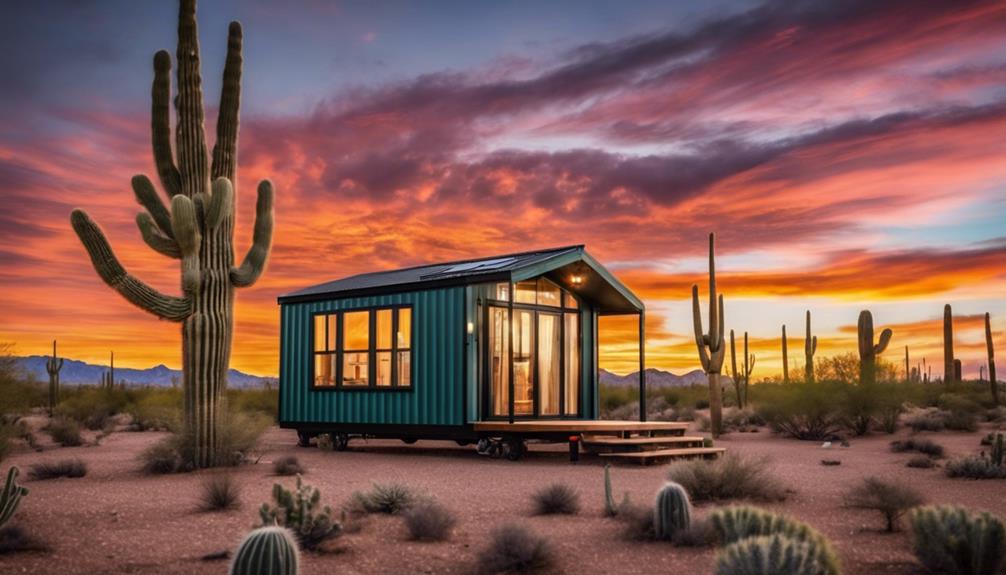
For those seeking ideal locations to establish their tiny homes in Arizona, cities like Phoenix, Tucson, Sedona, and Lakeside present attractive options. When considering where to set up your tiny home in Arizona, keep in mind that Pima County and Coconino County permit the establishment of tiny houses in specific zones. In these areas, tiny homes can be placed in isolated single-family zones, ADU zones, and multifamily zones. For those with tiny houses on wheels, it's important to note that they must be parked in designated R.V. zones in compliance with regulations.
- Phoenix, Tucson, Sedona, and Lakeside are ideal cities for setting up tiny homes in Arizona.
- Pima County and Coconino County allow tiny houses in specific zones.
- Tiny homes can be placed in single-family zones, ADU zones, and multifamily zones.
- Tiny houses on wheels must adhere to regulations in designated R.V. zones.
Tax Considerations for Tiny Home Owners
Exploring the tax implications of owning a tiny home in Arizona reveals potential benefits and considerations that can significantly impact financial planning for homeowners. Tiny home owners in Arizona may qualify for property tax exemptions based on factors like square footage and adherence to green building standards. Additionally, the size of tiny homes could lead to reduced property tax assessments in certain counties. It is crucial for Arizona tiny home owners to familiarize themselves with local tax laws to take advantage of any available tax benefits. Seeking guidance from a tax professional or local tax assessor can provide valuable insights into how owning a tiny home in Arizona may influence property taxes.
Tax Considerations for Tiny Home Owners:
| Key Points | Details | Importance |
|---|---|---|
| Property Tax Exemptions | Available based on square footage and green standards | Maximize Savings |
| Reduced Assessments | Smaller homes could mean lower tax bills | Financial Advantage |
| County Variances | Regulations differ, impacting tax benefits | Local Compliance |
| Professional Advice | Consult with tax professionals for guidance | Optimal Planning |
Finding Community Support in Arizona
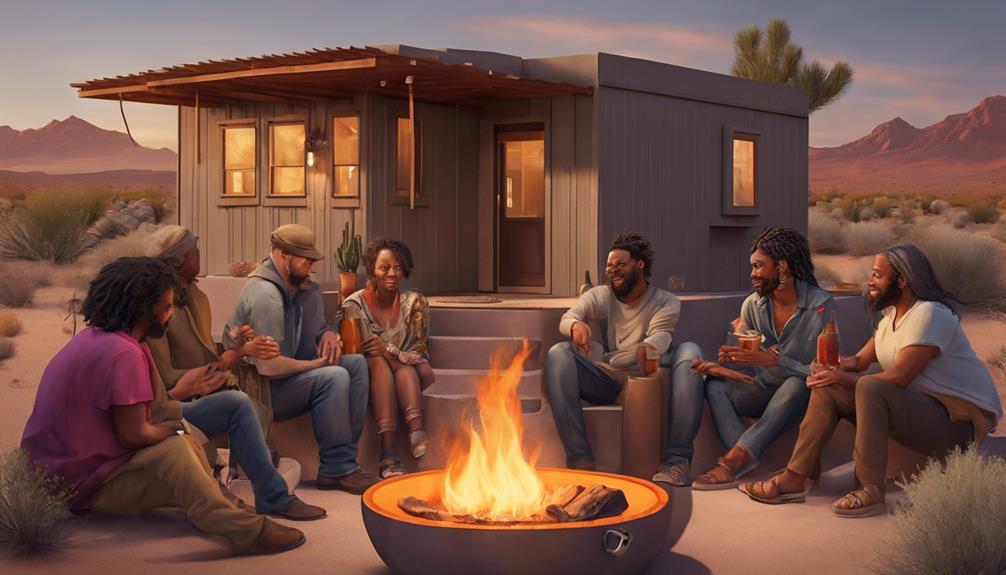
By actively engaging with local resources and networking opportunities, tiny home enthusiasts in Arizona can establish a strong sense of community support to enhance their living experience.
Here are some ways to find community support in Arizona:
- Join local Facebook groups like 'Arizona Tiny House Community' for a supportive network.
- Attend tiny house meetups and events in Arizona to connect with like-minded individuals.
- Explore tiny house workshops and seminars in the state to gain knowledge and resources.
- Consider volunteering with non-profit organizations focused on sustainable living and tiny house advocacy in Arizona.
These opportunities not only provide a sense of belonging within the tiny house community but also offer valuable insights, resources, and support for those embracing the tiny home lifestyle in Arizona.
Engaging with these avenues can enrich your experience, foster connections, and empower you to navigate the challenges and joys of sustainable living in the state.
Building and Parking Tips for Tiny Homes
Engaging with the regulations and guidelines for building and parking tiny homes in Arizona is crucial for ensuring compliance and a smooth transition into sustainable living. Tiny homes on foundations in Arizona must adhere to the 2018 IRC Appendix Q requirements, which outline specific space dimensions and safety features to guarantee structural integrity.
Building a tiny home on skids offers a semi-permanent placement option while still allowing for mobility if relocation becomes necessary. For those opting for tiny homes on wheels, meeting mobile home requirements is essential, and a minimum of 160 square feet is required for parking.
The flexibility in setting up tiny homes in various zone types in Arizona provides diverse housing options based on individual preferences. Tiny houses on wheels are particularly popular for their mobility and flexibility, making them an attractive choice for those desiring a minimalist lifestyle without sacrificing comfort.
Frequently Asked Questions
Can I Put a Tiny House on My Property in Arizona?
Yes, we can put a tiny house on our property in Arizona if it complies with local zoning regulations. Different options like multifamily, detached single-family, or accessory dwelling units are available. Land near Maricopa City, Pinal County, offers accessible placement.
How Much Does a Tiny House Cost in Az?
Tiny houses in Arizona can range from $20,000 to $200,000 depending on size and customization. DIY kits start at $8,000, but labor costs add up. Land, utilities, and permits are extra. Building a tiny house can be a cost-effective housing choice.
What Is the Minimum Square Footage for a House in Arizona?
In Arizona, the minimum square footage for a house varies based on its foundation type. For tiny houses on foundations, it's 200 square feet, while those on trailers require at least 160 square feet. Adhering to building codes is essential.
Does Arizona Have a Tiny Home Community?
We do have tiny home communities in Arizona. These communities provide shared amenities, community engagement, and a supportive environment. Living in a tiny house community offers a unique sense of belonging, shared resources, and a close-knit experience.
Conclusion
In conclusion, navigating the world of tiny homes in Arizona may seem like a daunting task, but with the right resources and community support, it can be a breeze.
From zoning laws to building tips, we've covered it all in our essential guide.
So go ahead, take the leap into tiny home living and watch your dreams of a cozy, sustainable lifestyle come to life in the Grand Canyon State!
- About the Author
- Latest Posts
Introducing Ron, the home decor aficionado at ByRetreat, whose passion for creating beautiful and inviting spaces is at the heart of his work. With his deep knowledge of home decor and his innate sense of style, Ron brings a wealth of expertise and a keen eye for detail to the ByRetreat team.
Ron’s love for home decor goes beyond aesthetics; he understands that our surroundings play a significant role in our overall well-being and productivity. With this in mind, Ron is dedicated to transforming remote workspaces into havens of comfort, functionality, and beauty.
Architecture Home Styles
Exploring the Difference Between Traditional and Classic Design
Kickstart your journey into the world of design by uncovering the subtle yet significant distinctions between traditional and classic styles, shaping your perception of timeless elegance.

When considering traditional versus classic design, we uncover nuanced distinctions in style and aesthetic preferences. The interplay between historical influences and contemporary interpretations provides a fascinating insight into the evolution of design principles.
As we explore the intricate details and subtle nuances that set these two styles apart, it becomes evident that each offers a unique perspective on elegance and sophistication.
Stay tuned to unravel the intricacies that define the essence of traditional and classic design, shedding light on the nuances that shape our perception of timeless aesthetics.
Key Takeaways
- Traditional design features bold colors and intricate patterns, while classic design opts for soft and subdued colors for elegance.
- Both traditional and classic design styles focus on creating a balanced, inviting, and harmonious atmosphere.
- Traditional furniture embodies moderation and balance with solid wood, while classic furniture exudes nobility with gilded finishes.
- Lighting in traditional design aims for warmth and coziness, while classic design creates a luxurious ambiance with ornate fixtures.
Key Elements in Traditional Design
In traditional design, we intricately weave together elements of moderation, elegance, and balance to create a timeless aesthetic inspired by the rich European design traditions of the 18th and 19th centuries. Solid wood plays a pivotal role in this style, exuding warmth and coziness throughout the space. The choice of fabrics like cotton, leather, and velvet further enhances the comfort aspect, inviting you to sink into luxurious textures. Lighting is carefully curated to emanate a soft and inviting glow, achieved through the use of ambient sources such as table lamps and floor lamps, setting a cozy ambiance.
The color palette in traditional design is a symphony of rich colors like deep reds, lush greens, and vibrant yellows, adding depth and character to the space. These hues evoke a sense of opulence and sophistication, harmonizing beautifully with the overall design scheme. The blend of these elements creates a space that not only exudes elegance but also envelops you in a sense of comfort and luxury.
Characteristics of Classic Design

Transitioning from the rich tapestry of traditional design, classic design embodies a timeless allure through its emphasis on neutral hues, enduring furniture pieces, and ageless patterns. Classic design is about creating a space that feels elegant and sophisticated, never going out of style. This style incorporates traditional furniture pieces like wingback chairs and claw-foot tables, showcasing intricate details and a focus on symmetry. Antique or vintage items are often integrated into classic interiors to enhance the sense of heritage and history. Natural materials such as wood and marble play a significant role in classic design, adding a touch of authenticity and luxury. The use of neutral colors like beige, ivory, and taupe creates a serene and calming atmosphere, perfect for those who appreciate a refined aesthetic. Classic design is about capturing the essence of timeless beauty and creating a space that exudes grace and elegance.
| Characteristics | Description | Example |
|---|---|---|
| Neutral Colors | Create a serene atmosphere | Beige, Ivory, Taupe |
| Traditional Furniture | Emphasize heritage and sophistication | Wingback chairs, Claw-foot tables |
| Intricate Details | Showcase fine craftsmanship | Ornate carvings, Embossed patterns |
| Natural Materials | Add authenticity and luxury | Wood, Marble, Leather |
| Timeless Patterns | Enhance the sense of elegance | Damask, Toile, Houndstooth |
Color Palette Variances
Let's delve into the captivating interplay of colors in traditional and classic design, unveiling their distinct palettes and the emotions they evoke within interior spaces.
Traditional design is known for its bold use of color, incorporating rich tones like red, green, and yellow to create a lively and accented color palette. In contrast, classic design opts for a more subdued approach, favoring neutral and soft colors that convey timeless sophistication and elegance. Both styles share a common emphasis on proportion and harmony when selecting colors, ensuring a visually pleasing aesthetic within the space.
Classic design often showcases prestigious materials with subtle contrasts, exuding an air of understated luxury. On the other hand, traditional design tends to embrace vibrant colors and intricate patterns, adding a sense of energy and warmth to the room. The careful selection of color palettes in traditional and classic design plays a vital role in shaping the overall ambiance and character of the interior, showcasing a harmonious blend of elegance, proportion, and timeless sophistication.
Differences in Furniture Styles

Embarking on a journey through the realm of interior design, we are met with a striking divergence in furniture styles between traditional and classic design aesthetics. Traditional furniture in European design, originating from the 18th and 19th centuries, embodies moderation, elegance, and balance. On the other hand, classic furniture exudes noble atmospheres with pomposity, showcasing prestigious materials like oak, mahogany, ceramic, marble, gold, and silver finishes.
| Traditional Furniture | Classic Furniture |
|---|---|
| Rooted in European design | Exudes ethereal nobility |
| Favoring moderation | Prestigious materials |
| Warmth and coziness | Gilded and opulent |
In traditional style, harmony is achieved through blending various elements, offering warmth and coziness with solid wood furniture and fabrics like cotton, leather, and velvet. In contrast, classic style features gilded finishes and gold leaf for a luxurious look, emphasizing richness and opulence. These styles also extend into lighting design, with traditional opting for warmer and softer lighting, creating a cozy feel with ambient lighting solutions like table lamps and floor lamps, while classic style leans towards ornate chandeliers and sconces for a grandiose touch.
Lighting Design Variances
As we delve into the realm of lighting design variances, a captivating interplay emerges between classic and traditional interior styles, each illuminating spaces with unique charm and character. Classic design exudes richness and opulence through lighting fixtures like grand chandeliers and intricately detailed sconces. These ornate details in classic lighting fixtures create a luxurious ambiance, evoking a sense of grandeur and sophistication within a space.
On the other hand, traditional design takes a softer approach, opting for warmer and cozier lighting solutions such as table lamps and floor lamps. The emphasis in traditional design is on creating a welcoming and comfortable environment, where ambient lighting plays a pivotal role in setting the mood. This style aims to promote a sense of intimacy and relaxation, steering away from the grandiose nature of classic design.
Both classic and traditional design styles strive for elegant lighting options that not only serve a functional purpose but also enhance the overall ambiance of a room. Whether it's the opulence of classic chandeliers or the cozy feel of traditional table lamps, lighting design plays a crucial role in shaping the character of a space.
Frequently Asked Questions
How Is Traditional Design Different From Modern Design?
Traditional design differs from modern design in various aspects.
We see traditional design focusing on warmth and rich colors like red and green, while modern design emphasizes sleek lines and minimalism.
Traditional design incorporates natural materials like wood for a cozy atmosphere, whereas modern design utilizes innovative materials for a contemporary look.
The former favors classic furniture with intricate details, while the latter features unique furniture and cutting-edge designs.
What Is the Definition of Traditional Design?
When it comes to traditional design, it's like stepping into a cozy retreat filled with elegant charm. Rich colors like red, green, and yellow dance together, creating a lively palette.
Classic lines and solid wood furniture greet you warmly, while fabrics like cotton and velvet whisper comfort and luxury. It's a timeless style that wraps you in a familiar embrace, making every corner of your home feel like a cherished memory.
What Is the Difference Between Modern Design and Classic Design?
When it comes to modern design and classic design, the distinction lies in their contrasting aesthetics.
Modern design embodies sleek lines and cutting-edge materials, reflecting a contemporary and innovative vibe.
In contrast, classic design exudes elegance and timeless sophistication with its traditional furniture and luxurious details.
These two styles offer a unique blend of old-world charm and futuristic elements, catering to different tastes and preferences in the world of design.
What Is the Difference Between Modern and Classic Home Design?
When it comes to modern and classic home design, the distinction lies in their essence.
Modern design embodies innovation and creativity with sleek lines and cutting-edge materials, ideal for those seeking a contemporary aesthetic.
Classic design, on the other hand, exudes elegance and sophistication through timeless pieces and intricate details, appealing to those who value tradition and refinement in their living spaces.
These contrasting styles offer unique choices for expressing personal taste and style preferences.
Conclusion
As we wrap up our exploration of traditional and classic design, it's clear that these styles offer unique and distinct characteristics. From the cozy warmth of traditional design to the timeless elegance of classic design, each style brings its own charm and sophistication to any space.
Whether you prefer the rich colors and intricate details of traditional design or the opulent finishes and neutral palettes of classic design, there's no doubt that both styles can create a truly stunning and inviting atmosphere.
So, which style speaks to you?
- About the Author
- Latest Posts
Introducing Ron, the home decor aficionado at ByRetreat, whose passion for creating beautiful and inviting spaces is at the heart of his work. With his deep knowledge of home decor and his innate sense of style, Ron brings a wealth of expertise and a keen eye for detail to the ByRetreat team.
Ron’s love for home decor goes beyond aesthetics; he understands that our surroundings play a significant role in our overall well-being and productivity. With this in mind, Ron is dedicated to transforming remote workspaces into havens of comfort, functionality, and beauty.
Architecture Home Styles
How to Explore Native Houses in Indonesia
Catch a glimpse of Indonesia's cultural treasures through native houses, where each intricate detail holds a secret waiting to be discovered.

So, you think you've seen it all in Indonesia? Well, think again. Exploring native houses in this diverse archipelago offers a glimpse into a world where tradition meets craftsmanship in a harmonious blend.
From the intricate carvings to the unique architectural designs, each house tells a story waiting to be uncovered, inviting us to step into a realm where time seems to stand still.
But what lies beyond the façade of these cultural gems is a journey that promises to unravel the tapestry of Indonesia's rich heritage, revealing a side often overlooked by many travelers.
Key Takeaways
- Visit Batak, Toraja, and Joglo Houses for diverse architectural experiences.
- Discover intricate carvings and symbolic details in traditional Indonesian homes.
- Immerse in cultural heritage through communal spaces and ancient craftsmanship.
- Learn about Indonesia's rich history and values by exploring native houses.
Traditional Houses in Indonesia
In Indonesia, traditional houses embody rich cultural heritage through their unique architectural designs and symbolism. Among these remarkable dwellings, the boat-shaped houses stand out for their distinctive characteristics. The Batak House, found in certain regions, showcases intricate carvings and utilizes natural materials, reflecting a deep connection to the environment. These boat-shaped structures not only serve as homes but also as symbols of cultural identity and traditions passed down through generations.
The boat-shaped design of these traditional houses in Indonesia not only provides shelter but also represents a deeper meaning within the community. The intricate carvings on the Batak House, for example, tell stories of ancestry and spiritual beliefs, adding layers of significance to the architectural aesthetics. Through these boat-shaped dwellings, the indigenous peoples of Indonesia honor their heritage and preserve their cultural roots in a rapidly changing world.
Cultural Significance of Indigenous Dwellings

Exploring the intricate cultural significances embedded within indigenous dwellings in Indonesia unveils a tapestry of architectural symbolism and traditional values that resonate deeply within the communities they inhabit. These houses serve as more than mere shelters; they embody the cultural beliefs and practices of the diverse Indonesian tribes. The multi-generational living arrangements seen in houses like the Rumah Gadang in West Sumatra and the Rong Houses in Dayak communities highlight the importance of family and community ties in Indonesian society.
Moreover, the communal living spaces found in the Tongkonan House in Tana Toraja and the Uma Lulik in Timor foster a sense of togetherness and shared responsibilities among the inhabitants. Each architectural element, from the intricate carvings to the circular shapes and elevated stilts, holds deep symbolic meaning rooted in centuries-old traditions. These indigenous dwellings aren't just physical structures but living embodiments of Indonesia's rich cultural heritage, where every beam and wall tells a story of cultural continuity and communal harmony.
Top Native Houses to Visit
With intricate architectural designs and rich cultural symbolism, a journey to explore the top native houses in Indonesia promises a captivating immersion into the country's diverse heritage. Here are some of the top native houses you shouldn't miss:
| Native House | Features |
|---|---|
| Batak Houses | Boat-shaped roofs, intricate carvings, spaces for daily life activities like a living room and dining room. |
| Toraja Houses | Distinct saddleback roof design, used in ceremonies, areas for daily life such as a living room and dining room. |
| Joglo Houses | Elaborate wooden structures, symbolizing social hierarchy, with designated spaces for a living room and dining room. |
These native houses offer insights into the daily lives of the people inhabiting them. From the communal spaces like the living room where gatherings take place to the dining room where meals are shared, each house reflects the cultural practices and traditions of its respective community. Exploring these spaces provides a unique opportunity to understand the interconnectedness between architecture, daily life, and cultural identity in Indonesia.
Exploring Architectural Features

Amidst the vibrant tapestry of Indonesia's architectural landscape, one encounters a rich mosaic of cultural intricacies within the native houses that stand as living testaments to the country's diverse heritage. As we delve into exploring the architectural features of these remarkable dwellings, we're greeted by a fusion of craftsmanship and symbolism that captivates the senses:
- Boat-shaped roofs that gracefully mimic the curves of traditional Indonesian vessels, offering a nod to the nation's maritime history.
- Intricate carvings adorning the facades and interiors, telling stories of myths, legends, and ancestral wisdom.
- Wooden craftsmanship that showcases the mastery of artisans, each piece meticulously crafted to perfection.
- Natural materials seamlessly integrated into the structures, connecting the homes to the earth and reflecting a harmonious relationship with nature.
- Symbolic details embedded in every corner, from the layout to the decorations, embodying cultural beliefs and societal values passed down through generations.
Exploring these architectural marvels unveils a world where history, artistry, and tradition converge in a celebration of Indonesia's rich cultural heritage.
Immersing in Indonesian Hospitality
Immerse yourself in the captivating tapestry of traditional Indonesian hospitality by residing in native houses like the Batak House in North Sumatra or the Rumah Gadang in West Sumatra. These native houses not only offer a place to stay but also provide a gateway to the cultural heritage of Indonesia. The intricate carvings, boat-shaped roofs, and eco-friendly construction of these houses showcase the deep-rooted traditions and craftsmanship of the local communities.
Here is a table highlighting some of the unique aspects of traditional Indonesian hospitality found in native houses:
| Aspect | Description |
|---|---|
| Architectural Features | Intricate carvings, boat-shaped roofs |
| Social Significance | Symbolism of social hierarchy in houses like the Joglo House in Central Java |
| Eco-Friendly Construction | Use of sustainable materials like bamboo and thatch in houses like the Sasak House in Lombok |
| Spiritual Connections | Preservation of spiritual connections and communal living traditions in houses like the Uma Lulik in Timor or the Honai House in Papua |
| Local Way of Life | Experience the daily lives and customs of the local communities while staying in these native houses |
Staying in these native houses will not only provide you with a unique accommodation experience but also a deep dive into the rich tapestry of Indonesian traditions and hospitality.
Frequently Asked Questions
What Are Traditional Indonesian Houses Called?
Traditional Indonesian houses are called 'Rumah Adat.' These structures are more than just dwellings; they're living representations of Indonesia's rich cultural tapestry. Crafted from natural materials like wood and thatch, they stand as testaments to the country's diverse traditions.
Each region boasts its own unique design, influenced by local customs and beliefs. Exploring these native houses allows us to delve into the heart of Indonesia's vibrant heritage and architectural ingenuity.
What Is Indonesian Housing Like?
Indonesian housing embodies a rich tapestry of cultures and traditions, showcasing unique architecture and sustainable practices. From boat-shaped roofs to intricate carvings, these homes reflect a deep connection to nature and community.
Families often live together in multi-story structures, fostering bonds and kinship. Sustainability and cultural symbolism intertwine in Indonesian homes, creating a harmonious blend of functionality and heritage preservation.
Each dwelling tells a story of tradition, innovation, and unity.
What Is Typical Indonesian Housing?
We'll dive into the essence of typical Indonesian housing, showcasing the diverse array of styles like Batak, Toraja, Joglo, and more. These houses boast unique architectural features, reflecting the rich heritage of Indonesia's indigenous communities.
From intricate carvings to bamboo and thatch construction, each house tells a story of cultural significance and tradition. Multi-generational living arrangements further deepen the bond between people, highlighting the social and spiritual connections within the community.
What Is a House Called in Indonesia?
In Indonesia, a house is often referred to as a 'rumah' in Bahasa Indonesia. These structures aren't merely places of dwelling; they embody the essence of Indonesian culture and heritage.
Each region has its unique names for traditional houses, such as 'rumah adat' or 'rumah suku,' showcasing the diverse architectural styles and craftsmanship.
These homes serve as living monuments, reflecting the country's history, beliefs, and social structure.
Conclusion
In conclusion, exploring native houses in Indonesia is like taking a journey through a living museum of cultural heritage. Each traditional dwelling tells a story of the past and present, showcasing the craftsmanship and traditions of its people.
By immersing ourselves in these architectural wonders, we can truly appreciate the beauty and diversity of Indonesia's indigenous cultures. So, let's hit the road and dive into the rich tapestry of Indonesian history – the world is our oyster!
- About the Author
- Latest Posts
Introducing Ron, the home decor aficionado at ByRetreat, whose passion for creating beautiful and inviting spaces is at the heart of his work. With his deep knowledge of home decor and his innate sense of style, Ron brings a wealth of expertise and a keen eye for detail to the ByRetreat team.
Ron’s love for home decor goes beyond aesthetics; he understands that our surroundings play a significant role in our overall well-being and productivity. With this in mind, Ron is dedicated to transforming remote workspaces into havens of comfort, functionality, and beauty.
-

 Vetted4 weeks ago
Vetted4 weeks ago15 Best Contact Paper for Kitchen Cabinets to Elevate Your Home Decor
-

 Vetted2 weeks ago
Vetted2 weeks ago15 Best Poe Cameras for Home Security – Reviews & Buying Guide
-

 Vetted4 weeks ago
Vetted4 weeks ago15 Best Drain Snakes to Unclog Your Pipes Like a Pro
-

 Beginners Guides1 week ago
Beginners Guides1 week agoI Inhaled Vinegar Fumes
-

 Beginners Guides3 weeks ago
Beginners Guides3 weeks agoSwinger Porch Light Color
-

 Mardi Gras Decoration4 weeks ago
Mardi Gras Decoration4 weeks agoWhy Does Hobby Lobby Not Do Mardi Gras?
-

 Vetted2 weeks ago
Vetted2 weeks ago15 Best Blinds for Bathroom Windows to Enhance Privacy and Style
-

 Vetted4 weeks ago
Vetted4 weeks ago15 Best Rat Traps to Safely and Effectively Rid Your Home of Rodents







![Best 42 Inch Ceiling Fans Under $100: Affordable and Effective Solutions [2024] 95 61FOGKbhRiL](https://byretreat.com/wp-content/uploads/2023/11/61FOGKbhRiL-80x80.jpg)









![Best 42 Inch Ceiling Fans Under $100: Affordable and Effective Solutions [2024] 110 61FOGKbhRiL](https://byretreat.com/wp-content/uploads/2023/11/61FOGKbhRiL-560x600.jpg)



![Best Belt Driven Ceiling Fans for Efficient and Quiet Airflow [2024] 141 518CH7yaBsL](https://byretreat.com/wp-content/uploads/2023/11/518CH7yaBsL-80x80.jpg)

![Best Solar Power Christmas Lights for a Bright and Eco-Friendly Holiday Season [2024] 143 71js B7oxIL](https://byretreat.com/wp-content/uploads/2023/11/71js-B7oxIL-80x80.jpg)